Birth Flower Chart: Complete Month-by-Month Chart of Every Flower and Its Meaning
Every month has its own bloom—a flower that mirrors the spirit of the season and the qualities of those born beneath it. A birth flower chart connects each calendar month to symbolic flowers, offering meanings drawn from centuries of folklore, poetry, and tradition. Like zodiac signs or birthstones, these blossoms tell a story about who we are, using nature’s language of color, fragrance, and form.
Across cultures, flowers have always carried messages. In ancient Greece, blossoms were linked to gods and myths. In Victorian England, flowers spoke for the heart when words were forbidden—a rose for love, a violet for loyalty, a daisy for innocence. The birth flower chart we use today evolved from those traditions, turning each month into a celebration of seasonal beauty and personal symbolism.
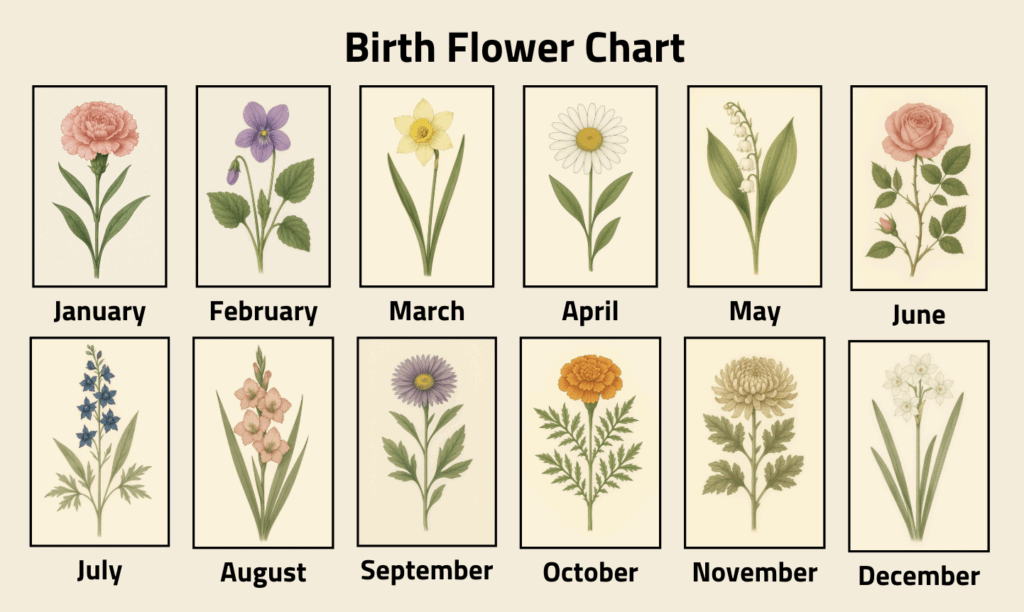
Whether you’re searching for a unique gift, exploring your connection to nature, or simply asking, “What is my birth flower?”This chart offers a beautiful way to see your personality reflected in the natural world.
What Is a Birth Flower Chart?
A birth flower chart is a guide that matches each month of the year with one or more symbolic flowers. These flowers represent the emotional and spiritual essence of the time they bloom, connecting our birthdays to nature’s rhythm. Most charts list a primary flower, and many also include a secondary flower, which varies by culture or region.
For example, January’s primary birth flower is the carnation, admired for its resilience and affection, while its secondary is the delicate snowdrop, which pushes through the frost to bloom in the heart of winter. Together they capture the themes of endurance and hope that define the month.
A birth flower chart can be used much like a birthstone or zodiac guide: to understand symbolic traits, celebrate birthdays, inspire floral gifts, or simply appreciate the poetic ties between human life and the natural calendar. Some even see their flower as a kind of floral totem, a reminder of their own growth and strength.
Below, you’ll find a detailed look at each month’s bloom. The expanded descriptions explore not only the flower’s symbolic meaning but also its history, folklore, and what it reveals about the people born in its season.
January: Carnation and Snowdrop
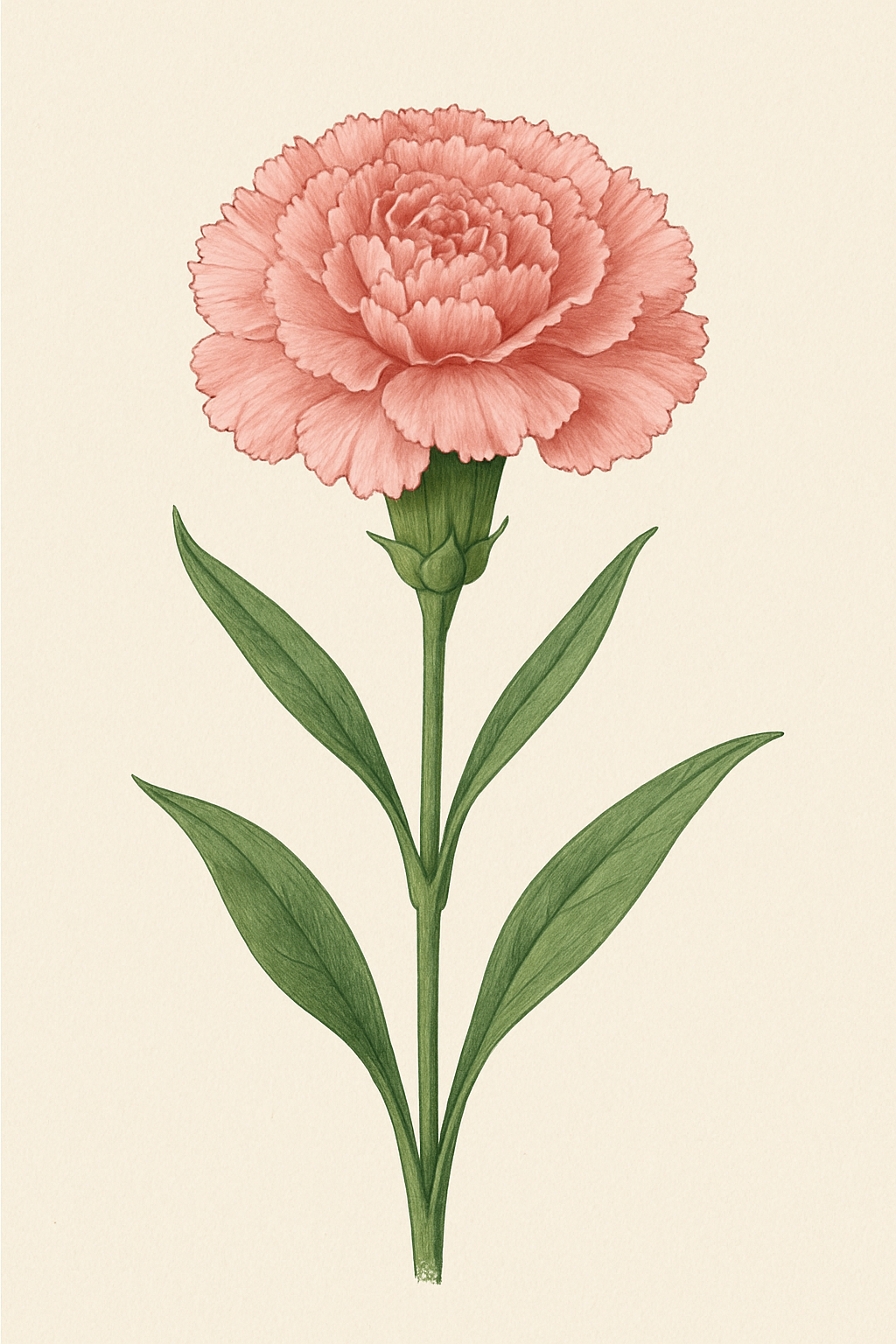
January opens the year in silence and frost, yet beneath its chill lies the promise of endurance and love. The carnation, January’s primary birth flower, has been cherished for centuries as a symbol of affection and strength. Its vibrant petals—ranging from white to pink to deep crimson—carry distinct meanings: white for pure love, pink for gratitude, and red for deep admiration. In the Victorian language of flowers, gifting a carnation was a way to say “I’ll never forget you,” reflecting the sign’s steadfast spirit.
Those born under the sign of the carnation are often loyal and dependable, carrying quiet warmth even through life’s cold seasons. They embody grace under pressure, offering strength and encouragement to those around them. The snowdrop, January’s secondary flower, adds another layer of symbolism. One of the first blooms to pierce the winter ground, it represents hope, purity, and renewal. Together, these two flowers speak to perseverance—the ability to endure hardship and emerge stronger and more radiant.
February: Violet and Primrose
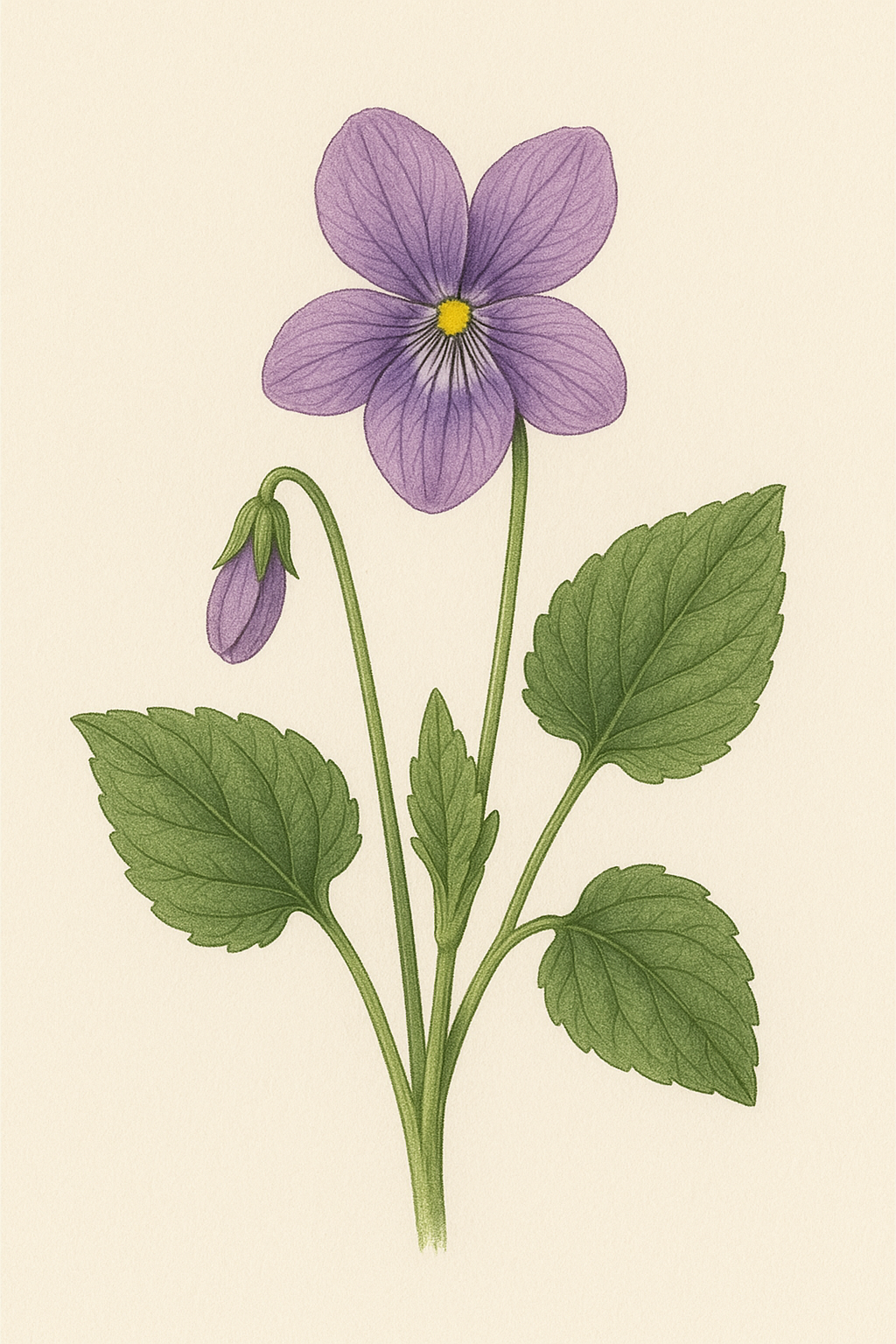
February’s chill is softened by the gentle beauty of the violet, a flower associated with loyalty, humility, and devotion. Historically, violets were sacred to Aphrodite, the goddess of love, and later became symbols of faithfulness in both Greek and Christian traditions. Their heart-shaped leaves and deep purple petals evoke sincerity and quiet strength—traits often found in those born this month.
Violet people are thoughtful, empathetic, and compassionate, often preferring depth to drama. They listen more than they speak and have a gift for making others feel understood. The primrose, February’s secondary birth flower, brings a brighter tone—its pale petals symbolize youth, renewal, and affection. In folklore, giving a primrose was a promise of love, a declaration of “I can’t live without you.” Together, these flowers express deep emotional honesty and enduring affection, making February’s births some of the most loyal and heartfelt of the year.
March: Daffodil and Jonquil

As winter loosens its grip, March bursts forth with the daffodil, the golden trumpet that announces spring. Its bright yellow bloom symbolizes rebirth, renewal, and joy. The daffodil’s arrival each year reminds us that even after darkness, light returns—making it a fitting flower for those born as the world reawakens. In Welsh legend, the first person to see a daffodil in spring is promised wealth and happiness for the year ahead.
People associated with the daffodil are often optimistic, cheerful, and full of creative energy. They see possibility in every challenge and have a natural gift for inspiring others. The jonquil, a variety of daffodil, adds a note of warmth and tenderness—it symbolizes affectionate love and sincerity. Together, these birth flowers speak to March’s vibrant energy: hopeful, generous, and always moving toward new beginnings.
April: Daisy and Sweet Pea

April, a month of rain and renewal, belongs to the daisy—a flower that symbolizes innocence, purity, and loyal love. Daisies open with the morning sun and close at night, a rhythm that represents trust and renewal. In Norse mythology, the daisy was sacred to Freya, goddess of fertility and motherhood, connecting it to themes of nurturing and fresh starts.
People born under April’s daisy are often joyful and sincere, with a refreshing openness that draws others in. They tend to see the good in people and have a knack for bringing lightness to heavy situations. The sweet pea, April’s secondary flower, adds a poetic contrast: it represents gratitude, delicate pleasure, and sometimes farewell. In Victorian times, sweet peas were given as a way to say “thank you for a lovely time.” Together, these two blooms paint April personalities as gentle, loving souls—grateful for the past, yet always looking forward with optimism.
May: Lily of the Valley and Hawthorn

May’s air is fragrant with blossoms, and none are sweeter than the lily of the valley—the tiny, bell-shaped flower that symbolizes humility, sweetness, and the return of happiness. In Christian lore, it’s said to have sprung from the tears of the Virgin Mary, earning it the nickname “Our Lady’s Tears.” In medieval times, it was woven into wedding garlands as a promise of everlasting love.
People born in May often share this flower’s gentle yet resilient nature. They are kindhearted, empathetic, and grounded, bringing peace wherever they go. Beneath their calm surface lies great emotional depth and quiet determination. The hawthorn, May’s secondary birth flower, complements this with a touch of protective energy. Known as the “fairy tree” in Celtic tradition, hawthorn symbolizes hope and renewal, its blossoms heralding the arrival of summer. Together, they reflect the steady warmth and grace of May-born individuals—gentle in nature, yet unshakably strong in spirit.
June: Rose and Honeysuckle

June is the heart of early summer, when days are long and love fills the air—and so it’s no surprise that its birth flower is the rose, perhaps the most iconic bloom of all. The rose has symbolized love, beauty, and passion since ancient times, appearing in mythology, art, and poetry across civilizations. Each color carries its own meaning: red for romance, pink for gratitude, white for purity, and yellow for friendship. To be born in June is to share in the rose’s timeless grace and emotional depth.
June-born people are often affectionate, expressive, and loyal, their warmth drawing others close. They value deep connections and have a flair for bringing beauty into everyday life. The honeysuckle, June’s secondary flower, adds notes of joy and devotion. Its sweet fragrance attracts pollinators and symbolizes bonds of love that grow stronger with time. Together, these two flowers celebrate passion and tenderness—the perfect reflection of the bright, blooming energy of midsummer souls.
July: Larkspur and Water Lily

July’s warmth calls forth the larkspur, a flower that symbolizes joy, positivity, and strong bonds of love. With its tall, colorful spikes in shades of pink, white, and violet, the larkspur represents an open heart and a generous spirit. In the Victorian language of flowers, it conveyed a message of laughter and lightness, reminding us to savor happiness and to share it freely. People born in July often reflect this exuberant energy — friendly, optimistic, and quick to lift the spirits of those around them.
Larkspurs also carry a note of sincerity, representing genuine affection without pretense. The water lily, July’s secondary flower, offers a quieter kind of strength. Rooted deep in the water yet rising to bloom on the surface, it symbolizes purity, enlightenment, and emotional balance. Together, these two flowers create a portrait of July-born individuals as radiant yet grounded — full of life and love, yet deeply in tune with their inner calm.
August: Gladiolus and Poppy
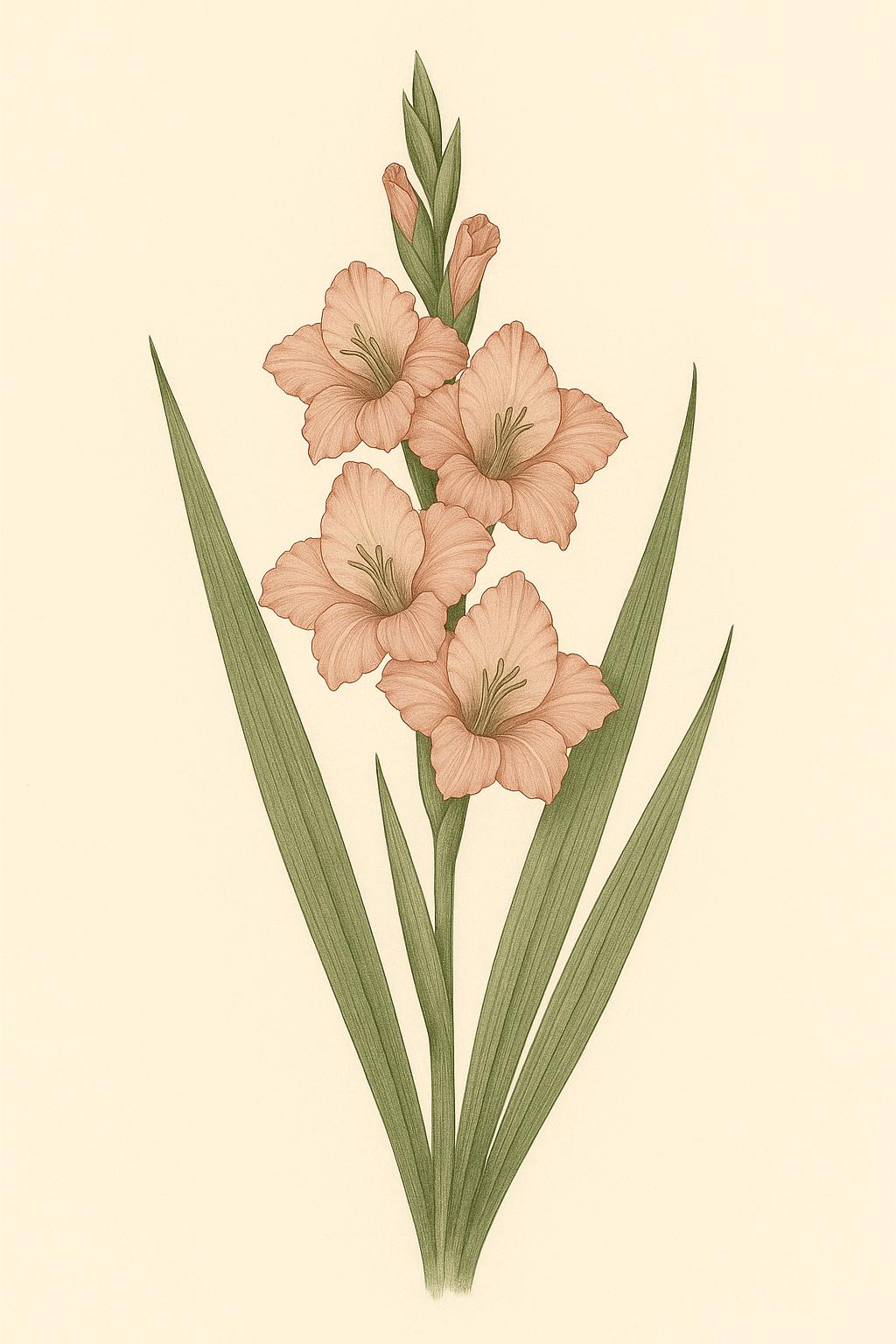
The height of summer belongs to the gladiolus, a flower that stands tall and proud, symbolizing strength, integrity, and resilience. Named after the Latin word gladius (meaning sword), the gladiolus was prized by the Romans as a symbol of victory and courage. It embodies the spirit of those who face life’s challenges with grace and determination. People born in August often share that same fearless energy — ambitious, loyal, and unafraid to stand for what they believe in.
The gladiolus also carries undertones of romantic passion, representing a heart “pierced with love.” The poppy, its companion flower, adds a dreamy balance. Poppies have long symbolized peace, remembrance, and imagination. In mythology, they were linked to sleep and the divine — a reminder of rest after effort, and beauty even in stillness. Together, these flowers portray August-born individuals as both strong and soulful, capable of great achievement without losing their compassion or creativity.
September: Aster and Morning Glory
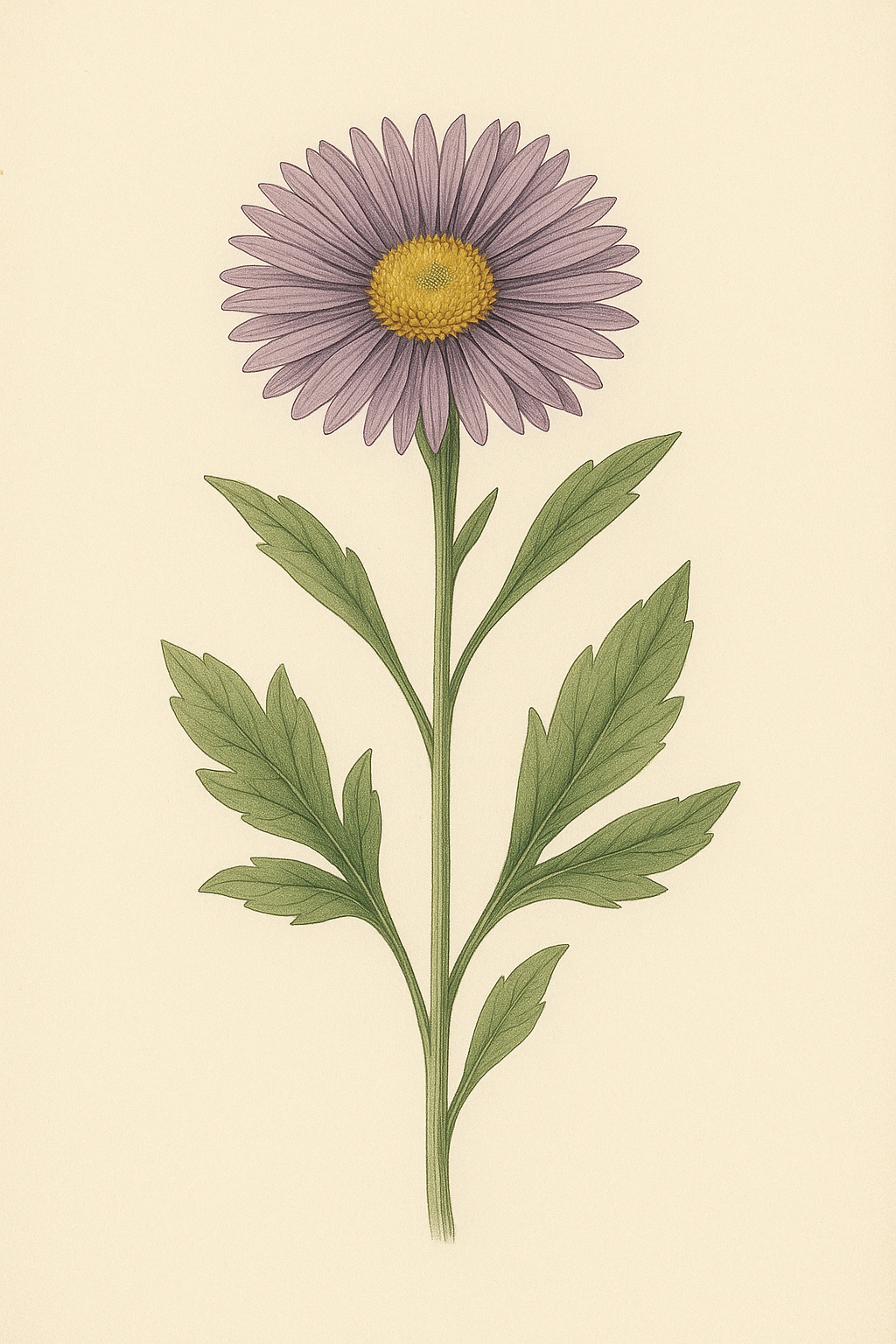
As summer fades into autumn, September brings forth the aster, a star-shaped bloom that symbolizes wisdom, faith, and love. Its name comes from the Greek word for “star,” and in mythology, asters were said to have formed from the tears of the goddess Astraea, who wept for humanity’s lost innocence. This celestial connection gives the flower an air of serenity and reflection. September-born individuals often share the aster’s calm wisdom and quiet strength, radiating light through thoughtful actions rather than grand gestures.
Asters come in many shades, from purple (symbolizing royalty and imagination) to white (representing purity and truth). The morning glory, September’s secondary flower, complements the aster beautifully. It blooms anew each day, opening with the sun and closing at dusk — a perfect metaphor for renewal and optimism. Morning glories teach that each day is a fresh beginning, no matter what came before. Together, these blooms symbolize the balance between reflection and hope that defines September souls: wise, steady, and eternally curious.
October: Marigold and Cosmos

October’s air glows golden, and its birth flowers reflect that fiery warmth. The marigold, known for its rich orange and yellow hues, symbolizes creativity, courage, and devotion. In ancient Aztec culture, marigolds were sacred offerings to the sun and later became central to Día de los Muertos traditions, where their bright petals guide spirits home. This connection between light and remembrance makes marigolds a symbol of resilience and faith. October-born people often mirror this vivid spirit — passionate, imaginative, and unafraid to stand out.
The cosmos, October’s secondary flower, brings balance to that intensity. Its name comes from the Greek for “order” or “harmony,” reflecting the flower’s perfectly symmetrical petals. Cosmos flowers represent peace, modesty, and inner beauty. Together, marigolds and cosmos show the dual nature of October personalities: fiery yet graceful, bold yet composed. They remind us that creativity and calm can coexist beautifully — a perfect reflection of autumn’s glowing equilibrium.
November: Chrysanthemum and Peony
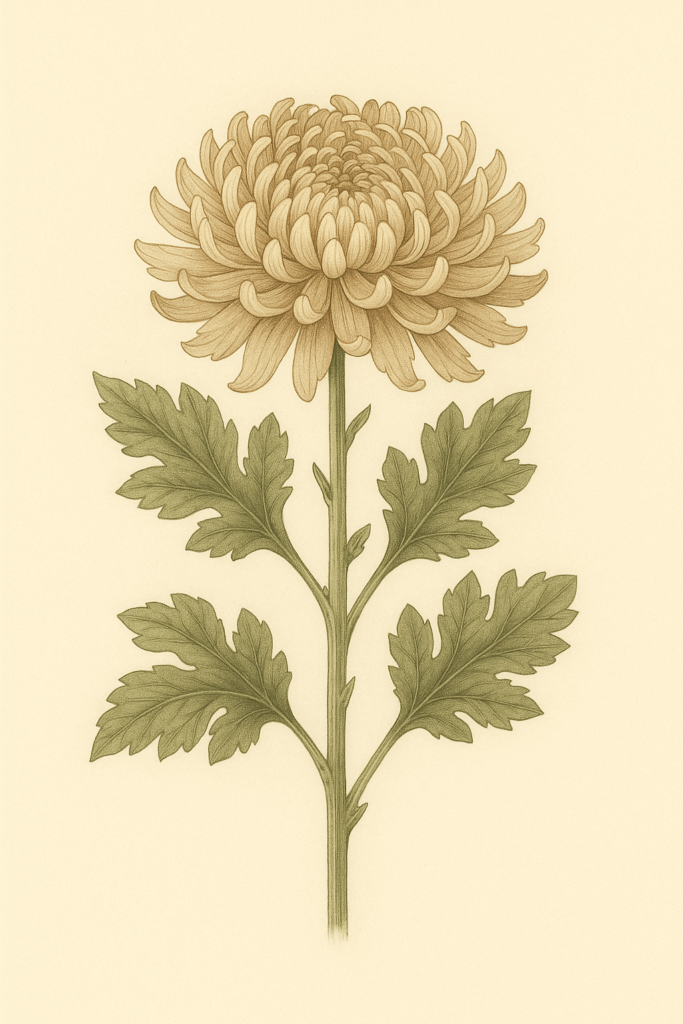
November, the quiet bridge between autumn and winter, is symbolized by the chrysanthemum — a flower that stands for loyalty, friendship, and longevity. In many cultures, the chrysanthemum represents optimism in the face of adversity. In Japan, it’s revered as the symbol of the emperor and the sun, associated with vitality and long life. November-born people share this enduring spirit: they are thoughtful, generous, and grounded, bringing warmth and stability wherever they go.
The peony, sometimes considered a secondary birth flower for November, adds romance and prosperity to the mix. Known as the “king of flowers” in Chinese tradition, the peony symbolizes honor, wealth, and love that endures. Together, chrysanthemums and peonies represent the balance between steadiness and heart — November individuals often blend practicality with deep emotion, offering loyalty that lasts through every season.
December: Narcissus and Holly
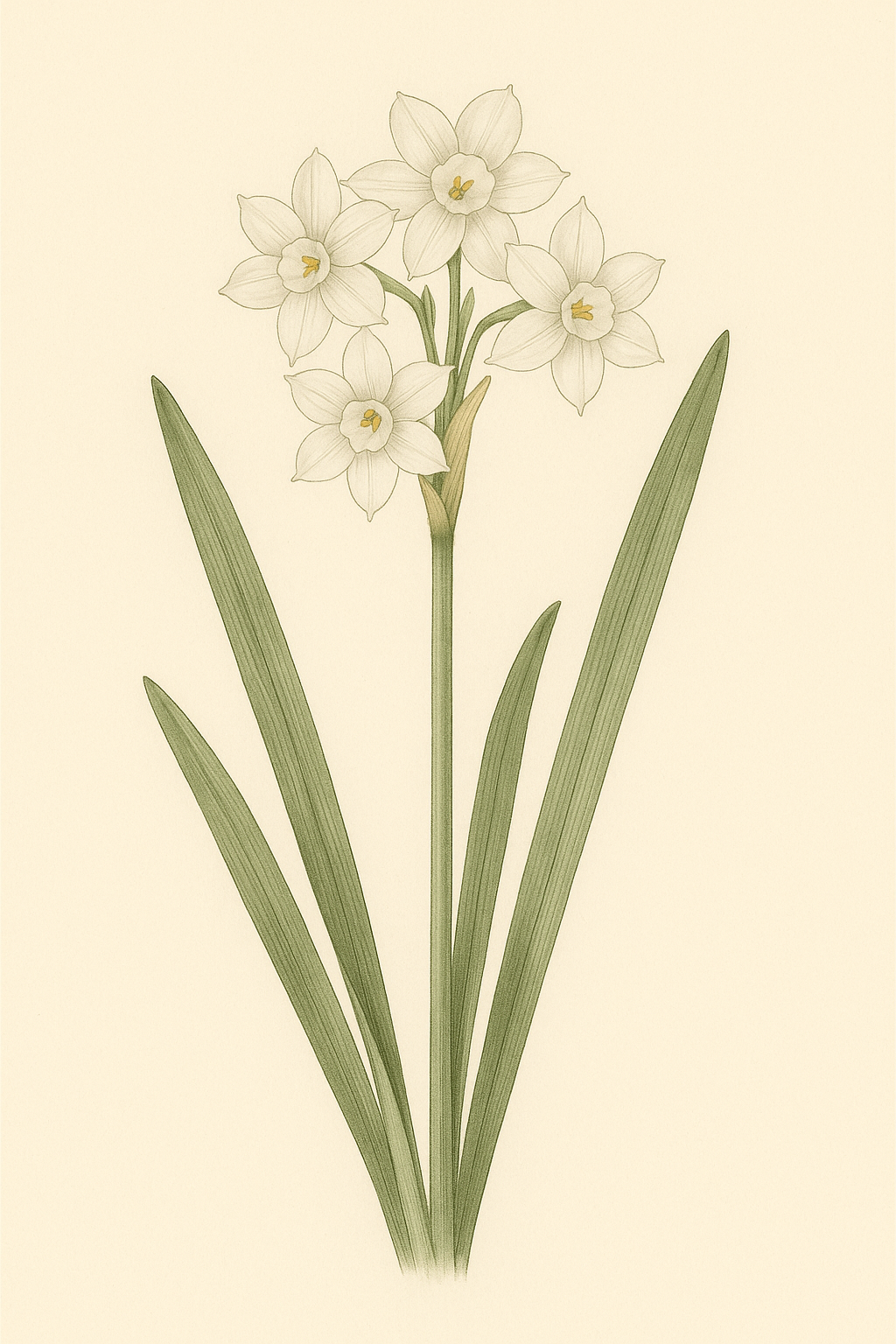
The year ends with the narcissus, often represented by the paperwhite, a delicate bloom that emerges in winter’s chill. This flower symbolizes hope, renewal, and good fortune. In Greek mythology, the narcissus was linked to self-awareness — a reminder of reflection and growth. December-born people often share this introspective quality; they look inward before taking action, valuing purpose and meaning over haste. Their quiet confidence and optimism bring light to even the darkest times of year.
The holly, December’s secondary flower, deepens that symbolism. With its evergreen leaves and bright red berries, it represents protection, endurance, and goodwill. In Celtic and Christian traditions alike, holly has long been a sign of faith and perseverance through hardship. Those born in December carry both of these energies — the introspective renewal of narcissus and the steady strength of holly. Together, they embody resilience, wisdom, and the joy of beginnings hidden within endings.
The Deeper Meaning of the Birth Flower Chart
Looking across all twelve months, the birth flower chart paints a picture of life’s cycles through nature’s blooms. From the endurance of January’s snowdrop to the reflective wisdom of December’s narcissus, each flower mirrors the emotional tone of its season. Spring months speak of growth and innocence; summer of love and vitality; autumn of reflection and gratitude; and winter of faith and renewal.
This cyclical symbolism reminds us that our personal growth mirrors the Earth’s rhythm. Just as flowers bloom and fade, we too experience phases of expansion, stillness, and rebirth. A birth flower isn’t just a pretty emblem—it’s a reflection of time itself, an ever-renewing metaphor for how we grow into the people we’re meant to be.
How to Use Your Birth Flower Chart
Understanding your birth flower chart is just the beginning—there are countless ways to weave it into your daily life, creative projects, or personal rituals.
1. Create a personal connection.
Spend time learning about your birth flower. Read its folklore, grow it in your garden, or keep it nearby as a symbol of your traits and strengths.
2. Gift with meaning.
Include someone’s birth flower in a bouquet or design a card featuring their bloom. It’s an easy way to make any gift more personal and symbolic.
3. Use it in art or jewelry.
Birth flowers make beautiful tattoo motifs, pendants, or prints. Many people combine their flower with a loved one’s, creating a “family bouquet” that tells their story through nature.
4. Pair it with your zodiac sign or birthstone.
For a deeper symbolic portrait, combine your flower’s traits with your astrological sign. For instance, a Capricorn born in January might see their carnation’s endurance echoed in their zodiac’s ambition.
5. Reflect and meditate.
Use your flower as a visual mantra during journaling or meditation. Ask yourself how its symbolism appears in your life—or how you’d like to embody it more fully.
The birth flower chart is a simple yet profound reminder that, like nature, we all grow in our own seasons—and that every bloom has its time to shine.
Birth Flower Chart FAQs
1. What is a birth flower chart?
A birth flower chart is a guide that connects each month of the year to one or more flowers representing traits, emotions, and seasonal symbolism.
2. How is a birth flower different from a zodiac sign?
While zodiac signs are based on celestial patterns, birth flowers come from Earth’s natural calendar. They focus on the emotions and symbolism of seasonal blooms rather than astrology.
3. Do all months have two flowers?
Not always. Some months have just one widely accepted bloom, while others include a secondary flower to honor regional traditions or climate differences.
4. Where did the idea come from?
The concept grew from Victorian-era “floriography,” or the language of flowers, and older seasonal associations in folklore and mythology.
5. Is there a connection between birth flowers and astrology?
Some people blend them symbolically—for example, pairing Leo’s fiery energy with August’s bold gladiolus or Cancer’s sensitivity with July’s serene water lily.
